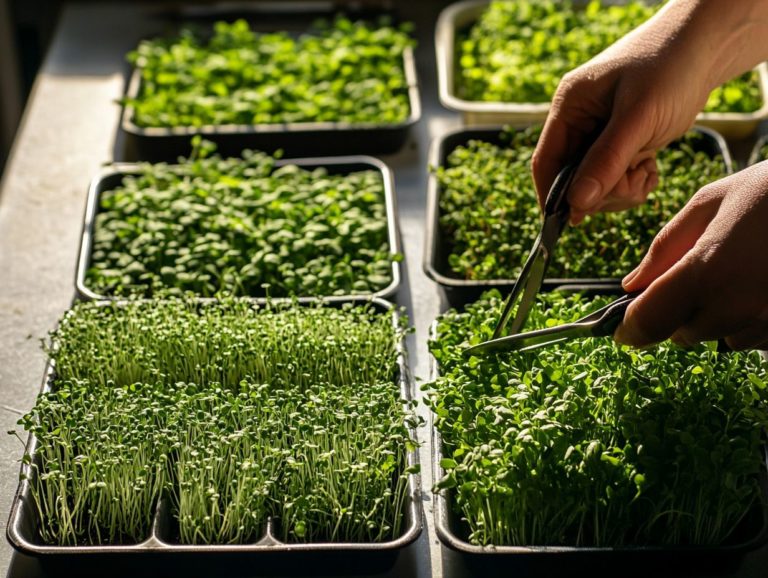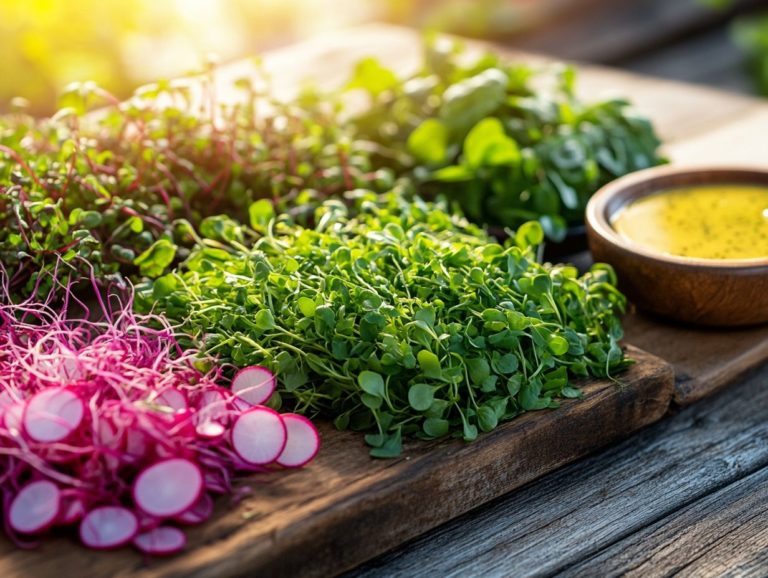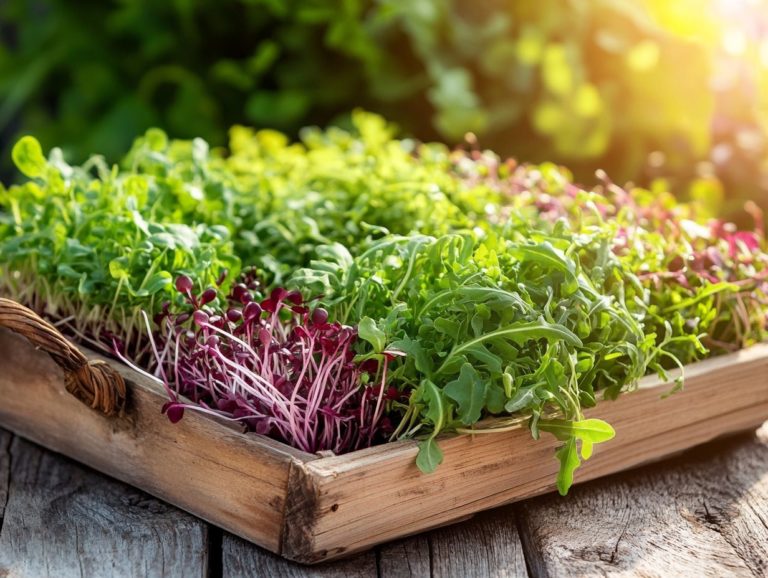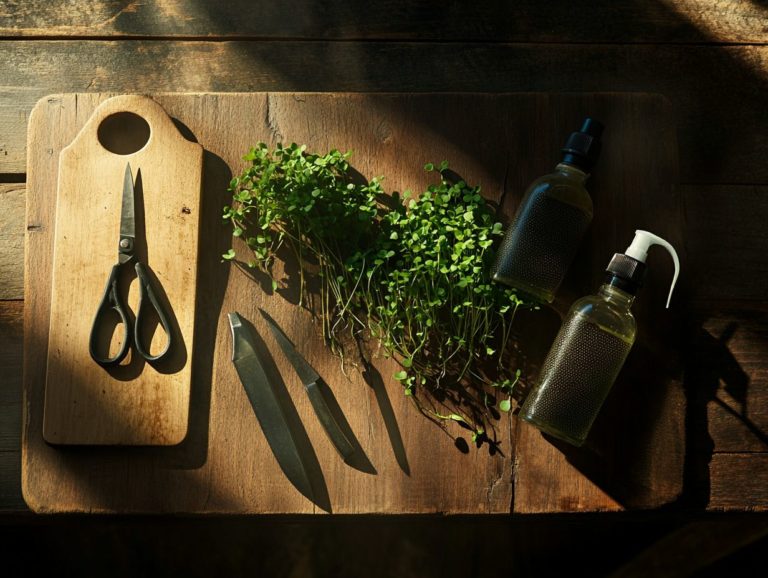The Role of Temperature in Microgreen Storage
Microgreens have surged in popularity, celebrated for their vibrant flavors and remarkable nutritional benefits. However, to fully savor their freshness, proper storage is essential.
Let s dive into the world of microgreens! We ll explore what they are, emphasizing their importance in your diet, while examining key factors that influence their storage particularly temperature and humidity.
You ll gain insights into the ideal conditions needed to keep these delicate greens fresh. Plus, practical tips will help you maintain their optimal quality!
Discover the vibrant world of microgreens today!
Contents
- Key Takeaways:
- Understanding Microgreens
- Importance of Proper Storage
- Factors Affecting Microgreen Storage
- Impact of Temperature on Microgreen Storage
- Best Practices for Storing Microgreens
- Frequently Asked Questions
- What is the ideal temperature range for storing microgreens?
- Why is temperature important in microgreen storage?
- Can microgreens be stored at room temperature?
- How long can microgreens be stored in the refrigerator?
- What happens if microgreens are stored at a higher temperature?
- Are there any tips for properly storing microgreens?
Key Takeaways:
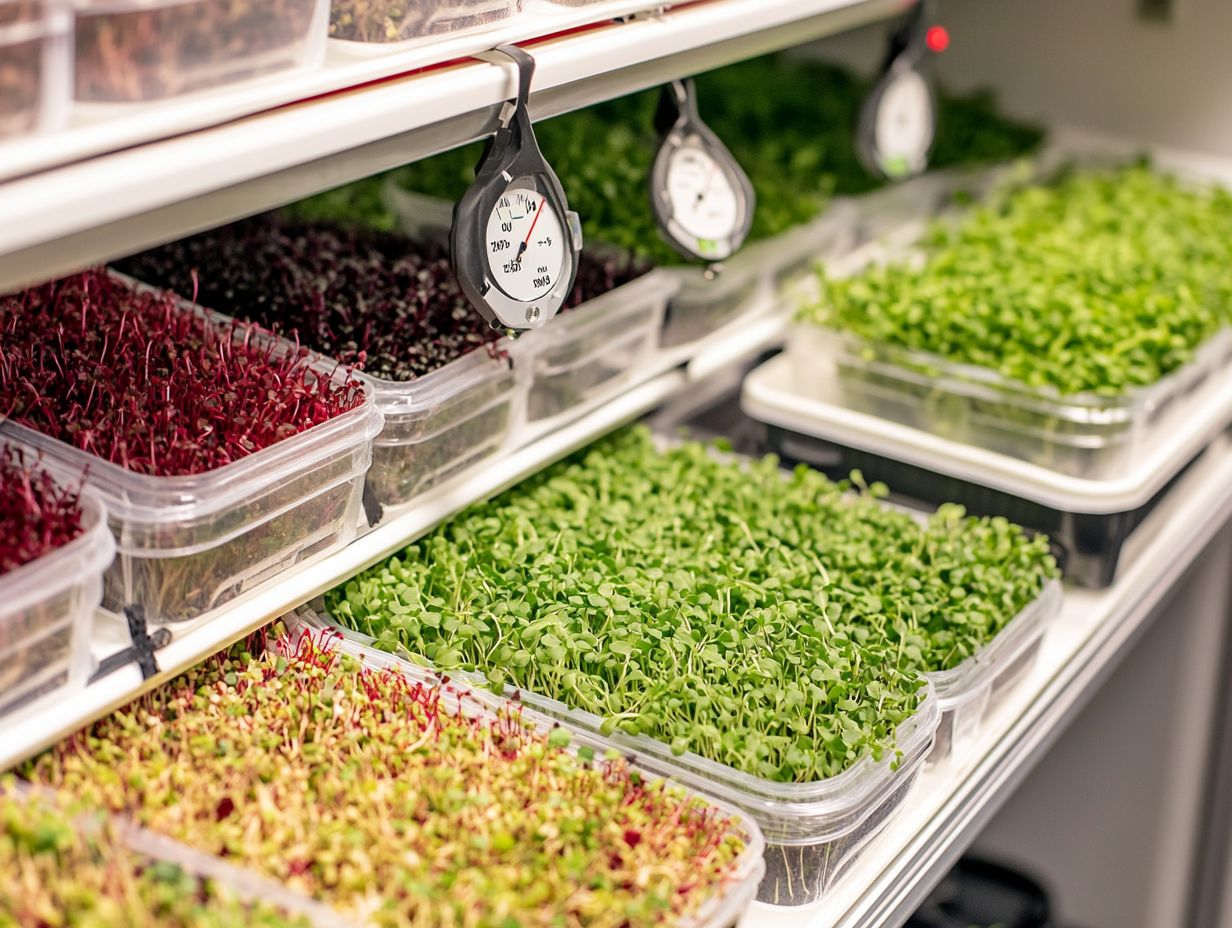
- Proper storage is crucial for maintaining the quality and shelf life of microgreens, whether you store them in a refrigerator or use other best containers.
- Temperature greatly affects how fresh your microgreens stay, making it essential to manage humidity and moisture effectively.
- Maintaining a consistent temperature between 33-39 F is recommended for optimal microgreen storage, particularly for varieties like broccoli, kale, and arugula.
Understanding Microgreens
Microgreens are delightful tiny greens that you can pick shortly after they sprout their first true leaves. They are a powerhouse of flavor and nutrients, making them beloved by both health-conscious consumers and gourmet chefs.
With varieties like broccoli, kale, arugula, radishes, and sunflower shoots, these vibrant plants don t just elevate the visual allure of your dishes; they also significantly boost their nutritional profile.
As the community of microgreen enthusiasts grows, knowing the different types and their unique benefits is essential for anyone looking to enhance their culinary experience.
What are Microgreens?
Microgreens are young, edible plants that you can pick shortly after germination. They boast robust flavors and impressive nutritional benefits.
These vibrant greens come in a delightful array of varieties, like arugula, radish, basil, and beet, each presenting unique tastes that range from peppery to sweet.
To cultivate them successfully, provide ample light, well-draining soil, and consistent moisture conditions that allow these delicate plants to truly thrive.
When it comes time to harvest, aim for those first true leaves. Handle them gently to preserve their fragile structure. Rich in vitamins and antioxidants, microgreens not only elevate the visual appeal of your dishes but also enhance their nutritional profile. They make a fantastic addition to salads, smoothies, and gourmet meals across various culinary traditions.
Importance of Proper Storage
Proper storage is essential for preserving the freshness and quality of microgreens, given their delicate nature. They are prone to wilting and spoilage.
By employing the right storage techniques, you can prolong their shelf life, maintain their nutritional value, and savor the vibrant flavors of microgreens for an extended time. For detailed advice on this, check out understanding microgreen post-harvest care. With thoughtful care, you’ll ensure that these nutrient-dense greens remain a staple in your diet, whether you’re buying them from a store or growing them in your own garden.
Why is Proper Storage Important for Microgreens?
Proper storage directly impacts the freshness, quality, and nutritional value of your microgreens. This ensures they stay safe and delicious to eat.
Without the right moisture management techniques, these delicate greens can lose vital nutrients that contribute to their impressive health benefits. When storage conditions fall short, you risk flavor degradation, leading to a bland and unappealing taste.
Improper handling or inadequate humidity control can increase the likelihood of spoilage, rendering them unsafe for consumption. Store your microgreens in a cool, dark place and consider using breathable containers to maintain optimal moisture levels.
Regularly check for any signs of decay. Implementing these practices helps preserve their quality and guarantees that every bite remains rich in flavor and nutrition.
So, why not try growing microgreens yourself? With these tips, you can enjoy their benefits and add a burst of flavor to your dishes!
Factors Affecting Microgreen Storage
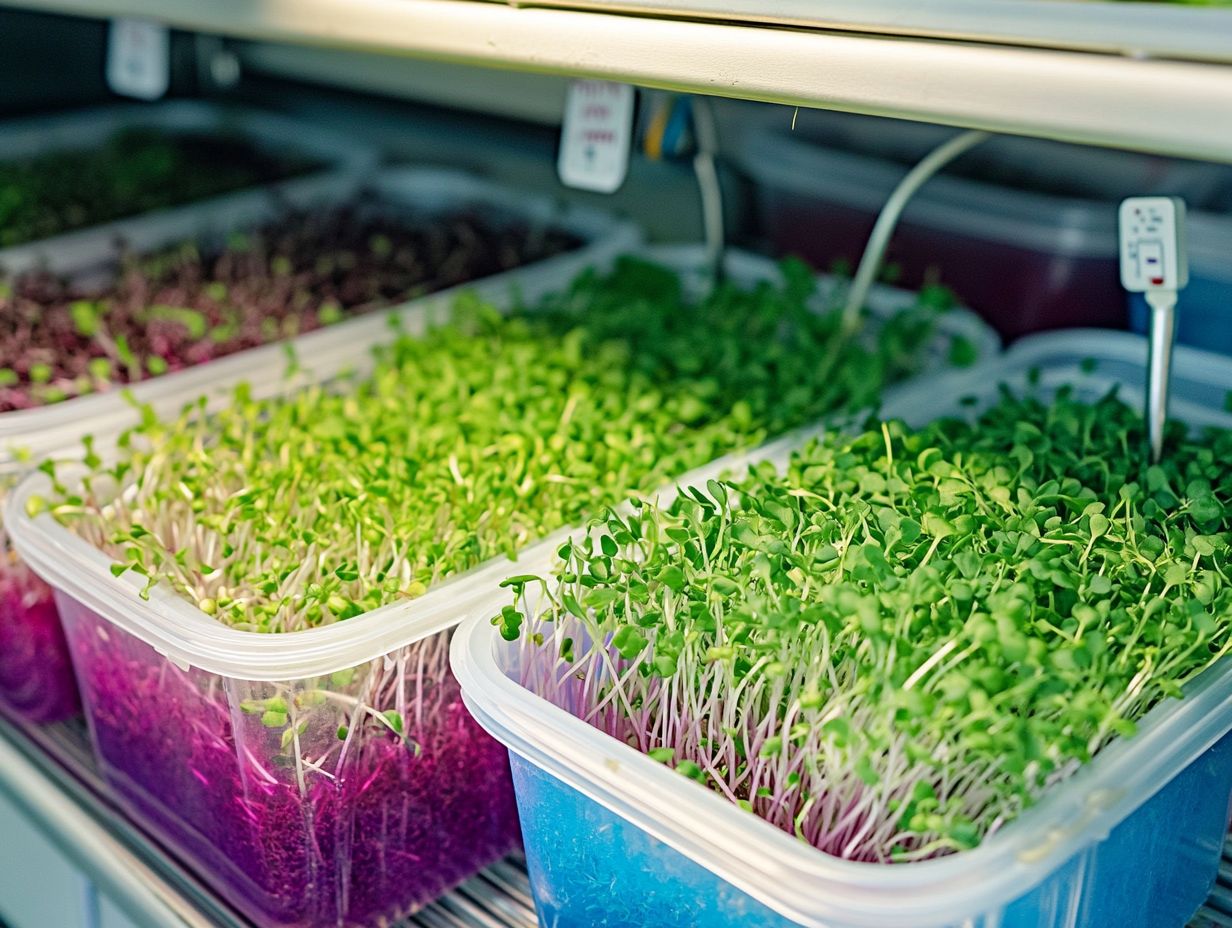
Several factors affect microgreen storage. These include temperature, humidity, moisture levels, and airflow.
To store your microgreens effectively, whether in your kitchen or a commercial environment, it s essential to understand these dynamics. By expertly managing these factors, you can preserve not just the flavor but also the nutritional value of your microgreens over time.
Temperature
Temperature is important in storing microgreens. Maintaining them within an ideal range is essential for preserving their freshness and quality.
Microgreens flourish best when kept in a temperature range of 60 to 70 degrees Fahrenheit, allowing them to retain their vibrant colors and robust flavors. High temperatures can cause these delicate greens to wilt or dry out excessively, leading to a significant loss of nutritional value and overall appeal.
Low temperatures can stifle their growth and flavor development, resulting in stunted growth and potential spoilage.
Understanding the effects of temperature fluctuations is crucial for anyone aiming to store microgreens effectively. This ensures they stay crisp, nutritious, and ready to elevate your culinary creations.
Humidity
Humidity plays a vital role in storing microgreens. It directly influences moisture management and determines whether your plants wilt or spoil.
By keeping the right humidity levels, you ensure these delicate greens retain their vibrant colors and crisp textures, which are essential for both their culinary appeal and nutritional value. However, excess moisture can invite mold and bacteria, while too little can cause rapid dehydration.
Proper airflow is key to keeping moisture levels right and preventing damage. By actively monitoring and adjusting your storage environment, you can significantly extend the freshness and shelf life of your microgreens, ultimately enhancing both storage efficiency and product quality.
Impact of Temperature on Microgreen Storage
Temperature plays a crucial role in the storage of microgreens. Both high and low temperatures can adversely affect their freshness and overall quality, impacting their flavor and nutritional benefits.
It’s essential to maintain the right conditions to preserve their vibrant taste and nutritional value.
Ideal Temperature Range
The ideal temperature range for storing microgreens typically falls between 32 F and 40 F. This range ensures they remain fresh and vibrant while retaining their nutrients.
Maintaining this temperature is essential for preserving their delicate flavors and textures, and for extending the shelf life of these nutritious greens. Certain varieties, such as arugula, radish, and basil, thrive particularly well within this optimal range, showcasing enhanced taste and longevity.
To create these ideal conditions, use a reliable thermometer and monitor temperatures regularly for consistency. Insulated containers or storage bags can effectively shield them from temperature fluctuations. Additionally, keeping them away from direct light and moisture will further enhance their freshness. For more information, check out what is the best temperature for microgreens?
By conducting regular checks, you ll be able to make necessary adjustments, ensuring your microgreens remain at their very best. Act now to ensure your microgreens stay bright and flavorful!
Effects of High and Low Temperatures
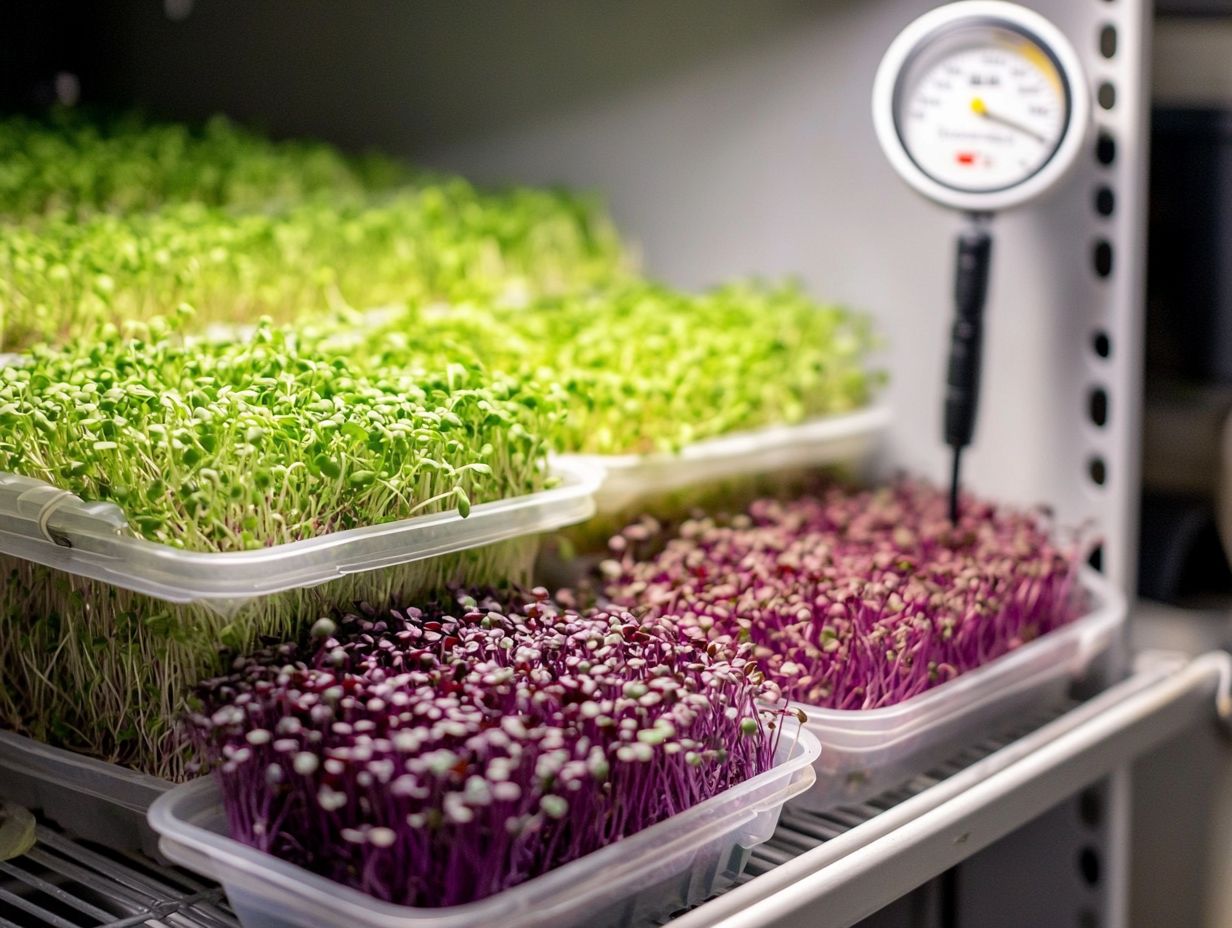
High and low temperatures can harm your microgreens. They can wilt, lose flavor, and decrease in nutritional value, making careful temperature management essential.
This is especially true for sensitive varieties like basil and arugula. These thrive in moderate conditions. Excessive heat can make basil leaves bitter and cause early flowering. Meanwhile, arugula may bolt, resulting in a tougher texture and a stronger peppery taste. Remember, factors like moisture and airflow are also important.
Conversely, extreme cold can stunt the growth of microgreens such as radish and sunflower. This leads to slower maturation and a bland flavor profile. Proper storage techniques can help reduce these effects.
Keeping a close eye on storage temperatures is crucial. Changes can risk their shelf life, affecting freshness and nutritional benefits for consumers.
Best Practices for Storing Microgreens
Embracing best practices for storing microgreens can greatly extend their shelf life and preserve their quality. This way, you ll savor their nutrients and vibrant flavors for as long as possible. Start implementing these tips today to enjoy your microgreens longer!
Tips for Maintaining Optimal Temperature
Maintaining the ideal temperature for storing microgreens requires attention to detail. Follow best practices to keep them fresh and nutritious.
Investing in a reliable thermometer is essential for monitoring your storage environment. Ideally, keep microgreens at a temperature between 32 F and 40 F. Even slight changes can lead to wilted leaves and a shorter shelf life, especially if moisture and airflow management are poor. For best practices, refer to these tips for washing and storing microgreens.
Use airtight containers, such as clamshells or plastic bags with ventilation, to regulate humidity while keeping your microgreens fresh. Regularly check the temperature to prevent unexpected changes, ensuring those delicate greens remain crisp and vibrant.
Frequently Asked Questions
What is the ideal temperature range for storing microgreens?
The ideal temperature for storing microgreens is between 35 F and 40 F. This range helps maintain freshness and prevents wilting or spoilage.
Why is temperature important in microgreen storage?

Temperature significantly impacts the freshness and shelf life of microgreens. You must control the temperature to prevent wilting and extend their storage time.
Can microgreens be stored at room temperature?
Storing microgreens at room temperature is not recommended. They are highly perishable and can spoil quickly. Room temperature is usually warmer than the ideal storage temperature, leading to wilting and nutrient loss.
How long can microgreens be stored in the refrigerator?
Microgreens can typically be stored in the refrigerator for up to 5 to 7 days. However, this may vary depending on the type of microgreens and how they were harvested and stored.
What happens if microgreens are stored at a higher temperature?
Storing microgreens at higher temperatures can cause wilting, loss of nutritional value, and quick spoilage. Maintaining the recommended storage temperature is vital for quality and freshness.
Are there any tips for properly storing microgreens?
Yes, it is recommended to store microgreens in a sealed container or plastic bag with a damp paper towel to maintain moisture. Place them in the refrigerator immediately after harvesting or purchasing to keep them fresh.
Summary: Proper temperature control is essential for maintaining the quality of microgreens. Use airtight containers, monitor temperatures, and act quickly to preserve their freshness.



